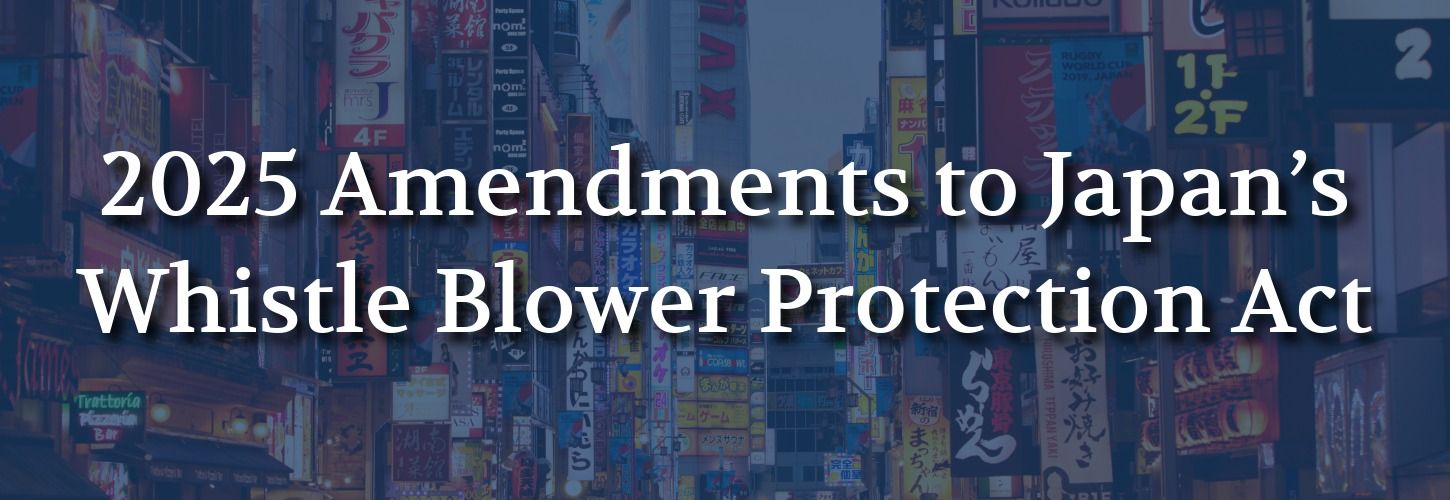This is a guest post by Nina Rodriguez of Spark Compliance, a Diligent brand.

On June 18, 2004, Japan enacted Act No. 122 – The Whistleblower Protection Act (“JWPA”) with the express purpose of “protecting whistleblowers by providing for nullity of dismissal and prohibition of disadvantageous treatment… and providing the measures… that an enterprise or administrative organ should take concerning whistleblowing disclosures…”1 Since its enactment, the JWPA has been updated several times (2020/2022) to require companies of a certain size to designate responsible personnel and establish internal reporting systems.2 In June 2025, in response to global trends and enforcement challenges, a bill was passed to partially amend the JWPA and strengthen protections and enforcement mechanisms.3 Through the 2025 amendments, Japan seeks to strengthen the system’s practical functionality and compliance.
The 2025 JWPA Amendments – Implications for Multinational Employers
The 2025 JWPA Amendments expanded the scope of protected individuals, strengthen enforcement measures, and heightened employer obligations. These amendments are shifting Japan’s regime towards global standards while incorporating regional-specific regulatory expectations. The below chart illustrates key changes:
| Key Change | Summary |
| Criminal Penalties for Retaliation | Up to ¥30M in corporate fines and up to 6 months in prison and/or fines for individual actors. |
| Expanded Scope of Protection | Coverage and protection extend to freelancers and workers for up to 12 months after the end of contractual engagement. |
| Prohibition on Identity-Seeking | Bans attempt to identify whistleblowers without legitimate justification; agreements restricting reporting are void. |
| Enhanced Powers of Consumer Affairs Agency (“CAA”) | Includes authority to issue orders, conduct on‑site inspections, and penalize non‑cooperation. |
The 2025 amendments also have significant implications for multinational employers with operations or subsidiaries in Japan, raising both compliance and operational expectations. Subsidiaries in Japan must align with local requirements while avoiding conflict with global whistleblowing frameworks, particularly when communication channels are operated centrally. They require not just compliance, but proactive preparedness, and effective operational systems. Failure to act could lead to legal, financial, operational and reputational risk. Implications include:
- Stronger Legal / Compliance Exposure: The amendments introduce criminal penalties for retaliation (up to ¥30 million for companies; individual liability including imprisonment or fines) and empower the CAA to issue binding orders, conduct on-site inspections, and impose sanctions for failing to designate responsible personnel or cooperate with investigations.
- Expanded Scope of Protection: Freelancers and individuals whose contracts ended within a year time frame and included within the meaning of protected individuals, meaning that entities cannot rely solely on employee-only systems to limit exposure. Multinational companies must ensure their local Japanese entity’s policies and systems align with these expanded protections, especially since global or regional whistleblowing frameworks may not have been designed to cover such categories.
- Interaction with Global Reporting Frameworks: For companies with a global or regional whistleblowing platform (e.g., one hotline for all countries), the amendments raise the risk of conflict between the group policy and Japan’s local legal requirements. For example, if an employee based in Japan reports concerns through a centrally operated global hotline, instead of a local reporting channel, and the HR in Japan pressures global compliance to reveal the reporter’s identity this may breach the new identity-protection rules. Implementing a system for Japan may require a locally designated WB responsible person, proper notification to employees, and clear protocols for how cross-border reports are handled.
- Documentation, Process & Culture Shift: The amendments emphasize not just the need to have a reporting channel but actively ensuring the effectiveness by informing employees of the system, preventing any attempt to identify whistleblowers unjustifiably, and ensuring the reporting mechanism functions well. For multinational companies, this means updating policies, training local managers, tracking metrics, aligning communication, and ensuring investigations are robust and documented. It’s a shift in expectations from “have a system” to “prove the system works.”
- Operational / Contractual Impacts: Because freelancers and ex-contractors are now protected under the JWPA, companies must review service contracts, vendor/supplier arrangements and ensure that these third-party relationships don’t become a vulnerability/risk. For example, if a long‑term freelance consultant raises a compliance concern involving a local government contract – terminating or reducing their engagement shortly after could be treated as retaliation under the expanded scope.
The 2025 JWPA v. The EU WB Directive4
Japan’s 2025 amendments are inching towards alignment with European‑style whistleblowing protection, although the framework remains less prescriptive than the EU Whistleblowing Directive. Still, come differences remain, for example Japan introduced criminal penalties and stronger regulatory oversight, while the EU mandates structured investigation timelines, broader entity coverage, and obligatory feedback to reporters. The table below compares key similarities and differences between the two regimes:
| Aspect | EU Whistleblowing Directive | JWPA (2025 Amendments) | Similarity / Difference |
| Protection from retaliation | Protects individuals reporting breaches of EU law through internal or external channels. | Provides protection for whistleblowers, with stronger enforcement mechanisms in 2025 (criminal penalties, expanded coverage). | Both emphasise protection from retaliation. |
| Communication Channels | Requires both internal and external channels with confidentiality safeguards. | Expanding to include broader internal systems; also allows external reporting. | Both expect robust systems and confidentiality protections. |
| Coverage / scope | Applies to all persons reporting breaches of Union law; includes workers and some non-employees depending on national transposition. | Extends to employees, freelancers, and former contractors (within 1 year). Coverage narrower than EU in practice. | The EU has a broader more harmonised scope. |
| Enforcement & regulator tools | Minimum standards: enforcement depends on national transposition (varies by Member State). | Introduces criminal penalties, presumption of retaliation (within 1 year), and regulatory powers via the CAA. | Japan’s regime adds explicit penalties and regulatory powers. |
| Organisational obligations | Requires entities (often above 50 employees) to establish confidential communication channels, feedback procedures, and follow-up processes. | Moving toward similar model but currently less prescriptive (e.g., feedback timelines not mandatory). | Evidences Japan’s rules are evolving toward EU standards. |
| Timing & maturity | Directive adopted 2019; most Member States have transposed or are implementing. | Amendments passed, expected to take effect within 18 months (by end of 2026). | Difference – EU framework is more mature. |
| Overall trend | EU-wide harmonisation of whistleblower protection. | Strengthened domestic framework aligning more closely with EU principles. | Both reflect global convergence toward stronger whistleblower protection norms. |

Preparing for Implementation
Multinational companies with ties to Japan should begin preparing now. Preparation could include:
- Conducting a Japan specific gap-analysis to assess whether a company’s local entity’s system meets the new requirements (for example – designated local individuals to address WB complaints, coverage of freelancers within specified time, training, documentation, etc).
- Aligning the global whistleblowing architecture with Japan’s requirements. Whether Japan uses the global hotline or a locally configured channel, how cross-border cases are handled, how confidentiality and data protection obligations are met.
- Updating policies and training materials to reflect the new criminal/regulatory risks, “within one year presumption” for adverse actions following a report, and prohibition of identity-seeking or obstructive agreements.
- Ensuring contract templates and supplier/vendor terms are reviewed so that freelance/contractor protections are reflected and no discrimination or termination risks exist post-report.
- Strengthening the governance and monitoring of the whistleblowing system: track key metrics, perform internal audits, prepare for inspections by the CAA, and document investigations/responses thoroughly.
Conclusion
The 2025 Amendments to JWPA mark a decisive step towards aligning Japan’s corporate compliance landscape with global best practices. By expanding protections, criminalizing retaliation, and empowering regulators with stronger tools for enforcement, the JWPA is signaling a shift from formal to demonstrative compliance. For multinational employers, these Amendments demand more than simple procedural updates – they call for cultural integration, proactive global and regional alignment, and transparent governance. Companies must act early and strengthen their internal systems, harmonize cross-border processes, train personnel and mitigate risk.
Reference List
- See Whistleblower Protection Act(Act No. 122 of 2004) available at https://www.japaneselawtranslation.go.jp/en/laws/view/4220/en?utm ↩︎
- See Dr. A Inoue, T. Ibaraki, et al., Japan: The Requirement for Whistleblowing Systems Under the Amended Whistleblower Protection Act, Backer Mckenzie (Feb. 2022) available at https://www.globalcompliancenews.com/2022/02/06/japan-the-requirement-for-whistleblowing-systems-under-the-amended-whistleblower-protection-act190122/?utm. ↩︎
- See S. Nomura and Y. Swada, Flash Report: Amended Whistleblower Protection Act Enacted – Background, Key Amednments, and Coporate Impact, Zelo Law Square (Jun. 20, 2025) available at https://zelojapan.com/en/lawsquare/57652?utm ↩︎
- See Directive of the European Parliament and of the Council on the Protection of Persons who Report Breaches of Union Law (Oct. 23, 2019) available at https://eur-lex.europa.eu/eli/dir/2019/1937/oj/eng?utm; D. Gunasekara, Amendment to the Whistleblower Law in Japan Create New Obligations, Penalties and Enforcement Powers, DLA Piper (July 16, 2025) available at https://knowledge.dlapiper.com/dlapiperknowledge/globalemploymentlatestdevelopments/2025/Amendments-to-the-Whistleblower-law-in-Japan-create-new-obligations-penalties-and-enforcement-powers?utm; T. Yoshida & S. Fujiwara, Japan: Publication of Interim Report on Review of Japanese Whistleblower Protection Act, Backer Mckenzie (Dec. 2024) available at https://insightplus.bakermckenzie.com/bm/dispute-resolution/japan-publication-of-interim-report-on-review-of-japanese-whistleblower-protection-act?utm. ↩︎